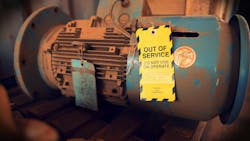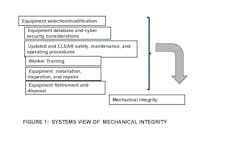Key Takeaways
- Mechanical Integrity (MI) is Essential for Safety and Compliance – MI ensures that mechanical equipment remains in good working order to prevent hazardous chemical releases, enhance worker safety and comply with OSHA’s Process Safety Management and EPA’s Risk Management Program regulations.
- A Systems and Lifecycle Approach Strengthens MI Programs – Effective MI requires interconnected systems such as equipment selection, maintenance, worker training and documentation, alongside a cradle-to-grave approach that includes proper disposal.
- Database Management and Risk-Based Prioritization Are Critical – A comprehensive, accessible, and cybersecurity-protected equipment database, along with risk-based equipment selection, predictive maintenance and regulatory adherence, is key to a successful MI program.
Stated broadly, mechanical integrity (MI) is a framework of policies and procedures ensuring all mechanical equipment stays in good working order for safe plant operation. In the United States, MI is a regulatory requirement under the Occupational Health and Safety Administration’s (OSHA) Process Safety Management rule 29 CFR 1910.119 (j) and the U.S. Environmental Protection Agency’s Risk Management Program (RMP). In other countries where it is not a regulatory requirement, MI can still be used to achieve and enhance a robust safety environment.
Astute process safety engineers quickly recognize vital importance of MI. It is axiomatic to say that if the mechanical equipment is sound and in a good working order, the plant will not have accidental release of hazardous chemicals, which, in turn, will improve worker safety and protect the surrounding community.
Despite its relatively obvious usefulness, several companies have had an unpleasant experience with implementation and upkeep of the MI. Enhancing the effectiveness of MI programs requires addressing several key challenges.
Systems and Lifecycle Approaches to MI
Some MI programs fail to ensure equipment integrity and/or regulatory compliance. Although there are myriad issues or items that tend to derail an MI program, two strategic factors account for many of these failures: the lack of both a systems and lifecycle approach. Figure 1 shows a systems view of MI.
The systems approach focuses on MI as multiple interconnected subsystems. MI is closely linked to several other programs or practices, including documentation, worker training, equipment selection, installation or maintenance and timely repairs. In addition, programs involved in equipment isolation, such as lockout tagout, line break and confined space entry and equipment modifications collectively play a vital role in ensuring robustness of an MI program.
The lifecycle or the cradle-to-grave approach factors in proper equipment selection, operation, maintenance and environmentally friendly retirement and disposal. In both a lifecycle and systems approach, we need to consider the following:
- Recognize that MI is not a one-person show. Along with the safety department, maintenance, engineering and operations are important parts of an MI. Given the interconnected nature of MI with various programs, risk reduction and MI's core objectives should remain the primary focus of these collaborative efforts. Safety and operating procedures need to be easy to understand. Before finalizing operating, maintenance and safety procedures, send them to your operators or technicians to make sure they understand. They are your first line of defense against safety mishaps.
- MI is not a one-time event — it is a continuum that requires revisions to support systems procedures.
- Worker training is critical when introducing new or modified equipment. Training and testing programs must ensure workers thoroughly understand equipment operation, maintenance procedures and testing protocols.
Mechanical Integrity Guidelines for Equipment Selection
Since the core objective of MI (and many other programs) is risk minimization, equipment and ancillaries selection should be based on the idea of the hierarchy of risk management, such as elimination, substitution, engineering controls and administrative procedures. As a corollary of this hierarchy, you also should have risk-containment measures if an unsafe event occurs.
Equipment and ancillaries should be in accordance with applicable design, safety and environmental standards.
Also, not every piece of equipment needs to be on the MI or its database. Equipment that’s considered critical or poses a high risk should take priority. OSHA and RMP regulations provide guidance on the risk threshold. In the locations where OSHA or EPA rules are not applicable, you can apply local regulations or your company’s risk tolerance for determining which equipment to include in your MI program.
You also can consider risk-based scenarios for equipment failures that could release hazardous chemicals. Depending on your company’s risk tolerance, you can select equipment or systems that qualify as “critical.” Typically, hazard and operability, and lockout/tagout sessions identify criteria for critical systems.
Keys to MI Program Success
The foundation of an effective MI program is a comprehensive and accessible equipment database. An effective and efficient MI requires a current database that shows relevant details of the equipment. Make sure the data is easily understandable by workers (including contractors) and easy to access. Provide adequate and prompt IT support. Obviously, the database you use should be easy to integrate with your existing documentation systems.
The database also should be easily understandable by all workers, including contractors; provide quick and simple access to critical information; integrate seamlessly with existing documentation systems; and maintain rigorous cybersecurity measures to protect sensitive information.
It’s also important to refer to the vendor’s instructions, industry standards and relevant regulations to establish MI equipment installation guidelines.
Equipment inspections should include a mix of manual inspections, such as operator rounds on inspections during a turnaround, inspections by online detectors, including vibration detectors, temperature/pressure detectors and alarms, or periodic non-destructive inspections, such as ultrasonic thickness checks, X-ray inspections and others.
There should be a system to analyze findings from the detectors to establish predictive maintenance schedules.
As equipment reaches the end of its useful life, it will need to be disposed of safely and environmentally compliant manner. If you decide to leave the idled equipment in place, provide a means of positive isolation. Consider potential hazards the equipment can pose by being idle, such as overpressure. Also provide relevant procedures for safe isolation of the idle equipment. Think of the risk to the idle equipment and risk it poses to the active equipment and workers.
MI as a Core Operational Strategy
MI is not simply a database management exercise. It should be viewed as an integral part of risk management. A disjointed or a piecemeal approach to MI is, as shown by many industrial incidents, will likely fail. A systems approach in conjunction with a lifecycle framework will help ensure efficacy and efficiency of your MI program. Of course, there are costs associated with MI. Without an effective MI, the potential for unsafe events rise — and in some high-risk situations it rises significantly.
A well-designed MI program is a critical investment in safety, risk mitigation and operational excellence that protects people, equipment and the environment. ⊕

